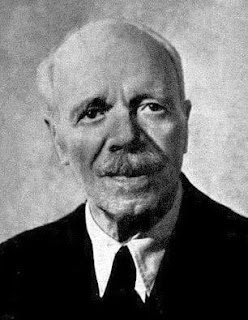Jim Corbett
𝐄𝐝𝐰𝐚𝐫𝐝 𝐉𝐚𝐦𝐞𝐬 𝐂𝐨𝐫𝐛𝐞𝐭𝐭 was an 𝐀𝐧𝐠𝐥𝐨-𝐈𝐧𝐝𝐢𝐚𝐧 𝐡𝐮𝐧𝐭𝐞𝐫, 𝐧𝐚𝐭𝐮𝐫𝐚𝐥𝐢𝐬𝐭 𝐚𝐧𝐝 𝐚𝐮𝐭𝐡𝐨𝐫 .
He was born to 𝐂𝐡𝐫𝐢𝐬𝐭𝐨𝐩𝐡𝐞𝐫 𝐖𝐢𝐥𝐥𝐢𝐚𝐦 𝐂𝐨𝐫𝐛𝐞𝐭𝐭 and 𝐌𝐚𝐫𝐲 𝐉𝐚𝐧𝐞 𝐂𝐨𝐫𝐛𝐞𝐭𝐭 on 𝟐𝟓 𝐉𝐮𝐥𝐲 𝟏𝟖𝟕𝟓 in 𝐍𝐚𝐢𝐧𝐢𝐭𝐚𝐥,a hill station in 𝐍𝐨𝐫𝐭𝐡𝐞𝐫𝐧 𝐈𝐧𝐝𝐢𝐚. Corbett spent much of his childhood exploring the jungles around 𝐍𝐚𝐢𝐧𝐢𝐭𝐚𝐥 and from these explorations and willing adults such as his eldest brother Tom, and a nearby headman named Kunwar Singh, he gained intimate knowledge of the habits of the local wildlife. He also began hunting, first with projectile weapons such as catapults and pellet bows, until being gifted an old muzzle-loading shotgun at the age of 𝐞𝐢𝐠𝐡𝐭.
Throughout his life, Corbett tracked and shot several 𝐥𝐞𝐨𝐩𝐚𝐫𝐝𝐬 and 𝐭𝐢𝐠𝐞𝐫𝐬, about a 𝐝𝐨𝐳𝐞𝐧 were well documented 𝐦𝐚𝐧-𝐞𝐚𝐭𝐞𝐫𝐬. He was frequently called upon by the Government of the 𝐔𝐧𝐢𝐭𝐞𝐝 𝐏𝐫𝐨𝐯𝐢𝐧𝐜𝐞𝐬 𝐨𝐟 𝐀𝐠𝐫𝐚 𝐚𝐧𝐝 𝐎𝐮𝐝𝐡 to kill 𝐦𝐚𝐧 𝐞𝐚𝐭𝐢𝐧𝐠 𝐭𝐢𝐠𝐞𝐫𝐬 and 𝐥𝐞𝐨𝐩𝐚𝐫𝐝𝐬 that were attacking people. Corbett provided estimates of human casualties in his books.According to Corbett's accounts, these big cats had killed more than 𝟏,𝟐𝟎𝟎 𝐦𝐞𝐧, 𝐰𝐨𝐦𝐞𝐧, and 𝐜𝐡𝐢𝐥𝐝𝐫𝐞𝐧.The first designated man-eating tiger he killed, the 𝐂𝐡𝐚𝐦𝐩𝐚𝐰𝐚𝐭 𝐓𝐢𝐠𝐞𝐫, was responsible for an estimated 𝟒𝟑𝟔 𝐝𝐨𝐜𝐮𝐦𝐞𝐧𝐭𝐞𝐝 𝐝𝐞𝐚𝐭𝐡𝐬.Other notable man-eaters he killed were the 𝐓𝐚𝐥𝐥𝐚-𝐃𝐞𝐬 𝐦𝐚𝐧-𝐞𝐚𝐭𝐞𝐫, the 𝐌𝐨𝐡𝐚𝐧 𝐦𝐚𝐧-𝐞𝐚𝐭𝐞𝐫, the 𝐓𝐡𝐚𝐤 𝐦𝐚𝐧-𝐞𝐚𝐭𝐞𝐫, the 𝐌𝐮𝐤𝐭𝐞𝐬𝐚𝐫 𝐦𝐚𝐧-𝐞𝐚𝐭𝐞𝐫, the 𝐂𝐡𝐨𝐰𝐠𝐚𝐫𝐡 𝐭𝐢𝐠𝐫𝐞𝐬𝐬, the 𝐏𝐚𝐧𝐚𝐫 𝐋𝐞𝐨𝐩𝐚𝐫𝐝 and the 𝐦𝐚𝐧-𝐞𝐚𝐭𝐢𝐧𝐠 𝐋𝐞𝐨𝐩𝐚𝐫𝐝 𝐨𝐟 𝐑𝐮𝐝𝐫𝐚𝐩𝐫𝐚𝐲𝐚𝐠. Corbett preferred to hunt alone and on foot when pursuing dangerous game. He often hunted with 𝐑𝐨𝐛𝐢𝐧, a small dog he wrote about in Man-Eaters of Kumaon.
Corbett was at the 𝐓𝐫𝐞𝐞𝐭𝐨𝐩𝐬, a hut built on the branches of a giant ficus tree, as the bodyguard of 𝐏𝐫𝐢𝐧𝐜𝐞𝐬𝐬 𝐄𝐥𝐢𝐳𝐚𝐛𝐞𝐭𝐡 when she stayed there on 𝟓–𝟔 𝐅𝐞𝐛𝐫𝐮𝐚𝐫𝐲 𝟏𝟗𝟓𝟐. That night, her father, 𝐊𝐢𝐧𝐠 𝐆𝐞𝐨𝐫𝐠𝐞 𝐕𝐈 died, and Elizabeth ascended to the throne.
He recounted his hunts and experiences in books like 𝐌𝐚𝐧-𝐄𝐚𝐭𝐞𝐫𝐬 𝐨𝐟 𝐊𝐮𝐦𝐚𝐨𝐧, which enjoyed commercial success. His book Man-eaters of Kumaon was a great success in 𝐈𝐧𝐝𝐢𝐚, the 𝐔𝐧𝐢𝐭𝐞𝐝 𝐊𝐢𝐧𝐠𝐝𝐨𝐦, and the 𝐔𝐧𝐢𝐭𝐞𝐝 𝐒𝐭𝐚𝐭𝐞𝐬 and was later translated into 𝟐𝟕 𝐥𝐚𝐧𝐠𝐮𝐚𝐠𝐞𝐬.Corbett's fourth book, 𝐉𝐮𝐧𝐠𝐥𝐞 𝐋𝐨𝐫𝐞, is considered his autobiography.
He also spoke out for the need to protect India's wildlife from extermination.The 𝐉𝐢𝐦 𝐂𝐨𝐫𝐛𝐞𝐭𝐭 𝐍𝐚𝐭𝐢𝐨𝐧𝐚𝐥 𝐏𝐚𝐫𝐤 in 𝐔𝐭𝐭𝐚𝐫𝐚𝐤𝐡𝐚𝐧𝐝, 𝐈𝐧𝐝𝐢𝐚 was renamed in his honour in 𝟏𝟗𝟓𝟕. He had played a key role in establishing this protected area in the 1930s.In 𝟏𝟗𝟔𝟖, one of the five remaining subspecies of tigers was named after him: 𝐏𝐚𝐧𝐭𝐡𝐞𝐫𝐚 𝐭𝐢𝐠𝐫𝐢𝐬 𝐜𝐨𝐫𝐛𝐞𝐭𝐭𝐢, the 𝐈𝐧𝐝𝐨𝐜𝐡𝐢𝐧𝐞𝐬𝐞 𝐭𝐢𝐠𝐞𝐫, also called 𝐂𝐨𝐫𝐛𝐞𝐭𝐭'𝐬 𝐭𝐢𝐠𝐞𝐫.
Corbett died of a heart attack aged 𝟕𝟗,on 𝟏𝟗 𝐀𝐩𝐫𝐢𝐥 𝟏𝟗𝟓𝟓 at 𝐍𝐲𝐞𝐫𝐢,𝐊𝐞𝐧𝐲𝐚.He was buried at 𝐒𝐭. 𝐏𝐞𝐭𝐞𝐫'𝐬 𝐀𝐧𝐠𝐥𝐢𝐜𝐚𝐧 𝐂𝐡𝐮𝐫𝐜𝐡 in 𝐍𝐲𝐞𝐫𝐢.
.jpeg)
.jpeg)




Sooooo Interesting.✌️✌️✌️✌️✌️
ReplyDelete